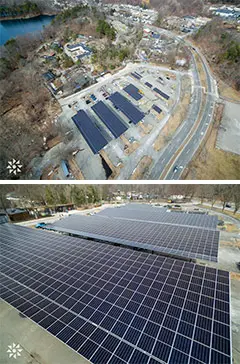As longtime readers of this blog already know, Zoo New England is committed to conservation. That means a lot of different things. Our participation in SSP’s (Species Survival Plans) ensures that the endangered animals in our collection can help prevent their species from going extinct. Our international conservation partnerships offer funding and expert support to people living alongside endangered wildlife across the world. The Field Conservation team works day and night to study, protect, and restore wild plants and animals right here in New England. All of these programs are important to accomplishing Zoo New England’s mission to inspire people to protect and sustain the natural world for future generations, but our commitment to safeguarding the environment goes even further than that.

If you’ve paid a visit to Stone Zoo in the past six months, you’ve surely noticed the large solar power project underway in the Stone Zoo parking lot. This project was supported by a $3 million dollar grant from the state of Massachusetts to reduce Stone Zoo’s reliance on fossil fuel power by 95%. We’re excited and proud to announce that as of January 19th, the solar array is running and producing clean energy! How much energy, you ask? Making the switch to power generated by the Stone Zoo solar array is the equivalent of avoiding burning 700,000 pounds of coal every year. In terms of reducing greenhouse gas emissions and fighting climate change, switching to the solar array is the equivalent of planting 800 acres of trees!
The new solar panels in the parking lot will have the added benefit of providing shade for zoo visitors and their parked cars during the hottest days of summer. Placing solar panels in an existing open and developed area like a parking lot also prevents wildlife habitat from being disrupted or destroyed by the creation of a solar farm – an environmental trade-off that can diminish the benefits of these renewable energy solutions. Where an existing tree in the parking lot had to come down to make way for the installation, a new tree was planted elsewhere on zoo grounds. Zoo New England staff also repurposed the cleared trees to add natural perches and logs to animal exhibits, as well as creating log seating in several education areas around the zoo.
With the threat of climate change looming large in the minds of conservationists all over the world, switching to greener energy is one small step we can take to create a brighter future for both humans and wildlife. What changes have you made in your own life to reduce your environmental impact? Let us know in the comments!
